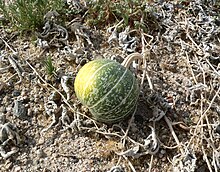Cucurbita palmata
| Cucurbita palmata | |
|---|---|

| |
| Scientific classification | |
| Kingdom: | Plantae |
| Clade: | Tracheophytes |
| Clade: | Angiosperms |
| Clade: | Eudicots |
| Clade: | Rosids |
| Order: | Cucurbitales |
| Family: | Cucurbitaceae |
| Genus: | Cucurbita |
| Species: | C. palmata
|
| Binomial name | |
| Cucurbita palmata | |

Cucurbita palmatais a species of flowering plant in thesquash familyknown by the common namescoyote melonandcoyote gourd.[1][2]It is similar toCucurbita californica,Cucurbita cordata,Cucurbita cylindrata,andCucurbita digitataand all these species hybridize readily.[3]It was first identified bySereno Watsonin 1876.[1]These species form the only restrictedxerophytespecies groupin the genusCucurbita.Each member of this species group is native to theSouthwestern United Statesand Northwestern Mexico where they are relatively uncommon. Each group member is found in hot, arid regions with low rainfall. They prefer soil that is loose, gravelly, and well-drained.C. palmatais native to northeasternBaja California,southeasternCalifornia,and southwesternArizonato a point near theColorado River.The juvenile leaves ofC. cylindrata,C. cordata,C. digitata,andC. palmatashow a high degree of similarity, but their mature leaves are visibly different, as are their root structures.C. palmataandC. digitataaresympatric,withC. palmataseparating the ranges ofC. digitataat the juncture of Baja California, California, and Arizona.C. palmatafruits are diffuse green mottle that turns yellow at maturity, striped, and round.[4]
Description
[edit]Cucurbita palmatais a sprawling vine with rough, stiff-haired stems and leaves. The dark green, light-veined leaves are sharplypalmatewith usually five long triangular points.
The stiff, curling yellow flowers are 6 to 8 centimeters wide. The plant bears smooth spherical oroblatesquash fruits 8 to 10 centimeters wide.
The fruits may be bright yellow to dark green and may have white stripes. The fruit is distasteful and not edible.[citation needed]
References
[edit]- ^abNee, Michael (1990). "The Domestication ofCucurbita(Cucurbitaceae) ".Economic Botany.44(3, Supplement: New Perspectives on the Origin and Evolution of New World Domesticated Plants). New York: New York Botanical Gardens Press: 56–68.doi:10.1007/BF02860475.JSTOR4255271.S2CID40493539.
- ^"Cucurbita palmata".Germplasm Resources Information Network.Agricultural Research Service,United States Department of Agriculture.RetrievedSeptember 14,2013.
- ^Puchalski, J. T.; Robinson, R. W. (1978)."Comparative Electrophoretic Analysis of Isozymes inCucurbitaSpecies ".Cucurbit Genetics Cooperative Report.1.Raleigh, NC: North Carolina State University: 28.
- ^Bemis, W. P.;Whitaker, Thomas W.(April 1969). "The XerophyticCucurbitaof Northwestern Mexico and Southwestern United States ".Madroño.20(2). California Botanical Society: 33–41.JSTOR41423342.
External links
[edit]![]() Media related toCucurbita palmataat Wikimedia Commons
Media related toCucurbita palmataat Wikimedia Commons
- IUCN Red List data deficient species
- Cucurbita
- Flora of California
- Flora of Nevada
- Flora of Arizona
- Flora of Baja California
- Flora of Sonora
- Flora of the California desert regions
- Flora of the Sonoran Deserts
- Natural history of the Mojave Desert
- Flora of the Sierra Nevada (United States)
- Plants described in 1876
- Squashes and pumpkins
- Cucurbitales stubs


